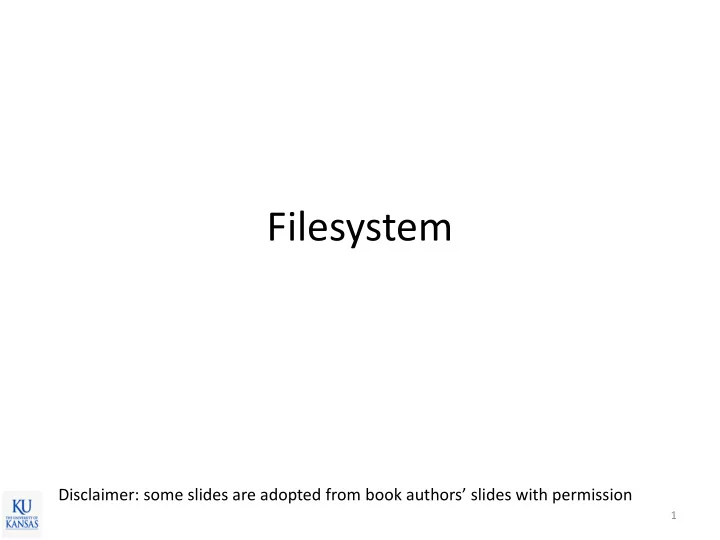

Filesystem Disclaimer: some slides are adopted from book authors’ slides with permission 1
Storage Subsystem in Linux OS User Applications User Kernel System call Interface Inode Directory Virtual File System (VFS) cache cache Filesystem (FAT, ext4, …) Buffer cache I/O Scheduler Hardware 2
Recap: Filesystem • Definition – An OS layer that provides file and directory abstractions on disks • File – User’s view: a collection of bytes (non-volatile) – OS’s view: a collection of blocks • A block is a logical transfer unit of the kernel (typically block size >= sector size) 3
Recap: Disk Allocation • How to map disk blocks to files? – Each file may have very different size – The size of a file may change over time (grow or shrink) • Disk allocation methods – Continuous allocation – Linked allocation – Indexed allocation 4
Recap: Continuous Allocation • Use continuous ranges of blocks – Users declare the size of a file in advance – File header: first block #, #of blocks – Similar to malloc() • Pros – Fast sequential access – easy random access • Cons – External fragmentation – difficult to increase 5
Recap: Linked-List Allocation • Each block holds a pointer to the next block in the file • Pros – Can grow easily • Cons – Bad access perf. 6
Recap: Indexed Allocation • Use per-file index block which holds block pointers for the file – Directory entry points to a index block (block 19) – The index block points to all blocks used by the file • Pros – No external fragmentation – Fast random access • Cons – Space overhead – File size limit (why?) 7
Recap: Quiz • Suppose each disk block is 2048 bytes and a block pointer size is 4 byte (32bit). Assume the previously described indexed allocation scheme is used. • What is the maximum size of a single file? • Answer – 2048/4 * 2048 = 1,048,576 (1MB) 8
Multilevel Indexed Allocation • Direct mapping for small files • Indirect (2 or 3 level) mapping for large files • 10 blocks are directly mapped • 1 indirect pointer – 256 blocks • 1 double indirect pointer – 64K blocks • 1 triple indirect pointer – 16M blocks 9
Multilevel Indexed Allocation • Direct mapping for small files • Indirect (2 or 3 level) mapping for large files • Pros – Easy to expand – Small files are fast (why?) • Cons – Large files are costly (why?) – Still has size limit (e.g.,16GB) 10
Quiz • Suppose each disk block is 2048 bytes and a block pointer size is 4 byte (32bit). Assume each inode contains 10 direct block pointers, 1 indirect pointer and 1 double-indirect pointer. • What is the maximum size of a single file? • Answer – 10 * 2048 + (2048/4) * 2048 + (2048/4)^2 * 2048 = 513MB 11
Concepts to Learn • Directory • Caching • Virtual File System 12
How To Access Files? • Filename (e.g., “project2.c”) – Must be converted to the file header (inode) – How to find the inode for a given filename? 13
Directory • A special file contains a table of – Filename (directory name) & inode number pairs $ ls – i project2/ 24242928 directory 25311615 dot_vimrc 25311394 linux-2.6.32.60.tar.gz 22148028 scheduling.html 25311610 kvm-kernel-build 22147399 project2.pdf 25311133 scheduling.pdf 25311604 kvm-kernel.config 25311612 reinstall-kernel 25311606 thread_runner.tar.gz Inode Filename number (or dirname) 14
Directory Organization • Typically a tree structure 15
Directory Organization • Some filesystems support links graph – Hard link: different names for a single file – Symbolic link: pointer to another file (“shortcut”) 16
Name Resolution • Path – A unique name of a file or directory in a filesystem • E.g., /usr/bin/top • Name resolution – Process of converting a path into an inode – How many disk accesses to resolve “/usr/bin/top”? 17
Name Resolution • How many disk accesses to resolve “/ usr /bin/top”? – Read “/” directory inode – Read first data block of “/” and search “ usr ” – Read “ usr ” directory inode – Read first data block of “ usr ” and search “bin” – Read “bin” directory inode – Read first block of “bin” and search “top” – Read “top” file inode – Total 7 disk reads!!! • This is the minimum. Why? Hint: imagine 10000 entries in each directory 18
Directory Cache • Directory name inode number – Speedup name resolution process • When you first list a directory, it could be slow; next time you do, it would be much faster – Hashing – Keep only frequently used directory names in memory cache (how? LRU) 19
Filesystem Related Caches • Buffer cache – Caching frequently accessed disk blocks • Page cache – Remember memory mapped files? – Map pages to files using virtual memory 20
Non Unified Caches (Pre Linux 2.4) • Problem: double caching 21
Unified Buffer Cache Page cache 22
Virtual Filesystem (VFS) • Provides the same filesystem interface for different types of file systems FAT EXT4 NFS 23
Virtual Filesystem (VFS) • VFS defined APIs – int open(. . .) — Open a file – int close(. . .) — Close an already-open file – ssize t read(. . .) — Read from a file – ssize t write(. . .) — Write to a file – int mmap(. . .) — Memory-map a file – … • All filesystems support the VFS apis 24
Recommend
More recommend